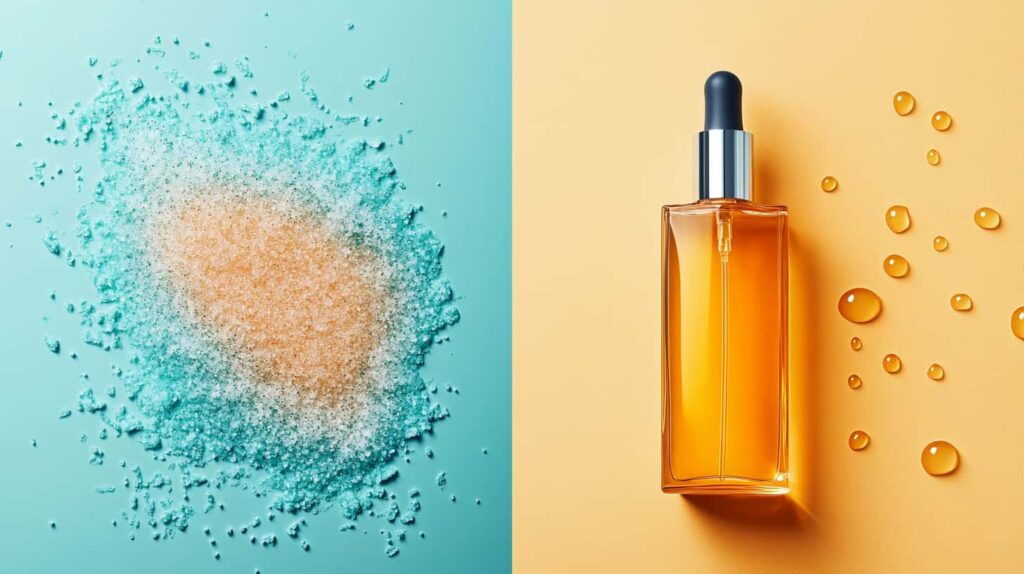Physical vs. Chemical Exfoliants: Pros & Cons
Exfoliation is a cornerstone of any effective skincare routine, yet choosing the right type can be confusing. In this article, you’ll discover the real differences between physical and chemical exfoliants. We’ll break down their unique benefits and potential drawbacks so that you can make an informed decision on which exfoliant suits your skin best. Whether you’re dealing with dullness, clogged pores, or uneven texture, this guide offers a friendly, science-backed perspective that simplifies your skincare journey.
You may have found yourself wondering, “Which exfoliant should I use—physical or chemical?” With so many products on the market, the debate over the best method to achieve smooth, radiant skin can be overwhelming. Exfoliation is designed to remove dead skin cells and promote cell turnover, but the process and results can vary greatly depending on the type of exfoliant you choose.
Physical exfoliants work by manually scrubbing away dead cells using abrasive particles or tools, while chemical exfoliants use acids or enzymes to dissolve the bonds between skin cells. Both methods have their unique advantages and potential pitfalls, and understanding these can transform your skincare routine.
This article is tailored to help you navigate the world of exfoliation, especially if you’re a busy professional or a skincare enthusiast in India looking for a clear, effective solution. By exploring the pros and cons of both methods, you’ll gain practical insights on how to select and safely use exfoliants based on your skin type and concerns. We’ll dive into the basics of exfoliation, explain the science behind each method, compare their effectiveness, and offer actionable tips to avoid common mistakes.
By the end of this guide, you’ll have a comprehensive understanding of both physical and chemical exfoliants, enabling you to choose the right approach for achieving healthier, more luminous skin. Let’s get started and clear up the confusion once and for all.

Understanding Exfoliation: The Basics
Exfoliation is the process of removing dead skin cells from the surface of your skin to reveal fresher, more vibrant skin underneath. It’s an essential step in your skincare routine that not only helps improve skin texture and tone but also enhances the effectiveness of your other skincare products.
There are two main types of exfoliants: physical and chemical. Physical exfoliants include scrubs, brushes, and microdermabrasion tools that mechanically slough off dead cells. On the other hand, chemical exfoliants utilize ingredients like alpha-hydroxy acids (AHAs), beta-hydroxy acids (BHAs), and enzymes to break down the bonds holding dead cells together, allowing them to be washed away easily.
For many, the choice between these two methods comes down to personal preference, skin sensitivity, and the specific issues you wish to address. Physical exfoliation can offer immediate results, leaving your skin feeling smoother right away. However, it can be harsh if used too frequently or if the particles are too abrasive. Chemical exfoliation, while gentler for some skin types, may require a period of adjustment as your skin adapts to the acids.
Understanding these fundamentals is crucial as you consider which method aligns best with your skin’s needs. By incorporating regular exfoliation into your routine, you can not only improve the appearance of your skin but also prevent issues such as clogged pores and dullness. In the sections that follow, we’ll explore the distinct advantages and limitations of both physical and chemical defoliants, helping you to make a well-informed decision

Physical Exfoliants: How They Work & Their Pros
Physical defoliants work by using a manual action—whether through scrubs, brushes, or microaggression devices—to physically remove dead skin cells from the surface of your skin. These products typically contain small, textured particles like sugar, salt, or synthetic beads that help slough away the old cells when massaged into the skin.
One of the key benefits of physical exfoliation is the immediate gratification it provides. When you use a scrub, you can often feel the difference right away as your skin becomes noticeably smoother and more polished. This method can also stimulate blood circulation, giving your skin a natural, healthy glow. For many people, especially those with normal to oily skin, physical defoliants can help unclog pores and reduce the buildup of impurities that lead to breakouts.
Another advantage is the versatility of physical exfoliation. It’s available in a variety of formulations—ranging from gentle cleansers with fine particles to more robust scrubs designed for tougher exfoliation. This means you can choose a product that matches your skin type and your specific concerns, whether you’re looking to brighten dull skin or prepare your face for better absorption of serums and moisturisers.
Additionally, physical defoliants often come in the form of face brushes or tools that can be used in conjunction with cleansers. These devices not only provide exfoliation but also massage the skin, enhancing blood flow and promoting a more youthful appearance over time.
However, it’s important to use physical defoliants correctly to maximise their benefits and minimise potential damage. When applied with too much pressure or used too frequently, physical defoliants can lead to micro-tears in the skin, irritation, and increased sensitivity. Despite these risks, when used properly, physical exfoliation offers an effective, quick-fix method to boost your skin’s radiance and texture.
Physical Defoliants: Cons & Potential Drawbacks
While physical defoliants provide immediate smoothing benefits, they do come with a few potential drawbacks that you should consider. One of the primary concerns is that the abrasive nature of these products can sometimes lead to over-exfoliation. If used too aggressively or too frequently, physical defoliants can create micro-tears in the skin, which may result in irritation, inflammation, and even accelerated raging over time.
For those with sensitive or compromised skin, the harsh particles in some scrubs can trigger redness and exacerbate conditions like aerospace or eczema. Even individuals with normal skin types need to be cautious—using a physical exfoliate improperly can strip the skin of its natural oils, leading to dryness and a compromised skin barrier.
Another drawback is that physical exfoliation can sometimes be less uniform than chemical exfoliation. The manual nature of the process means that some areas may receive more attention than others, resulting in an uneven texture. Additionally, the results of physical exfoliation are often short-lived; while you might see an immediate improvement in skin smoothness, dead skin cells can build up again quickly if the underlying issues aren’t addressed.
It’s also worth noting that not all physical defoliants are created equal. The quality and size of the exfoliating particles play a significant role in determining whether the product will be effective or damaging. Opting for a product with finely milled particles and using it sparingly can help mitigate these risks. Ultimately, while physical defoliants offer a quick fix for dull skin, it’s crucial to use them with care and awareness to avoid long-term harm.
Chemical Defoliants: How They Work & Their Pros
Chemical defoliants take a different approach by using acids or enzymes to gently dissolve the bonds between dead skin cells, allowing them to be rinsed away with water. Ingredients such as alpha-hydro acids (A Has), beta-hydro acids (Bash), and natural fruit enzymes are common in these formulations. Unlike physical exfoliate, chemical exfoliates work without the need for scrubbing, making them a preferred option for those who are prone to irritation or have sensitive skin.
One of the significant advantages of chemical exfoliation is its ability to provide a more uniform and controlled removal of dead skin cells. Since the acids work at a microscopic level, they can reach areas that might be missed by manual scrubbing. This results in a more even skin texture and improved radiance over time. For many, the gradual and consistent use of chemical defoliants leads to a noticeable reduction in fine lines, improved skin tone, and a smoother overall appearance.
Chemical defoliants also offer additional benefits beyond just removing dead skin. Many formulations include ingredients that help to stimulate collagen production, enhance skin hydration, and even reduce hyper pigmentation. For example, glycol acid, an AHA, not only exfoliates but also boosts collagen synthesis, which can improve the elasticity and firmness of your skin.
Another key benefit is that chemical defoliants can be tailored to various skin types. Formulations with lower concentrations of acids can be effective for those with sensitive or dry skin, while stronger formulations may be better suited for oily or acne-prone skin. This versatility means you can select a product that precisely meets your skin’s unique needs.
In essence, chemical defoliants offer a gentler, more even approach to skin renewal. Their ability to improve skin texture and promote long-term benefits makes them an excellent choice for anyone looking to enhance their skincare routine without the physical abrasion that comes with scrubs.
Chemical Defoliants: Cons & Considerations
Despite their many benefits, chemical defoliants are not without potential drawbacks. One of the most common concerns is the risk of skin sensitivity. Since acids work by breaking down the bonds between skin cells, they can sometimes cause irritation, redness, or a stinging sensation-especially if your skin is not used to them or if you use them too frequently.
Overuse of chemical defoliants can also lead to a compromised skin barrier. This may result in dryness, flakiness, and increased vulnerability to environmental factors like UV rays and pollution. It’s important to follow the product instructions carefully, starting with lower concentrations and gradually increasing usage as your skin builds tolerance.
Additionally, chemical defoliants can make your skin more sensitive to sunlight, necessitating the use of sunscreen every day. This extra step is crucial to prevent further damage and hyper pigmentation. If you have sensitive skin or a condition like aerospace, you may need to choose products that are specifically formulated to be gentle, and consider consulting with a dermatologist before introducing chemical defoliants into your routine.
Lastly, finding the right balance can be challenging. While chemical defoliants can provide excellent results, improper use can backfire. It’s all about listening to your skin and adjusting your routine accordingly. With careful use and proper guidance, you can enjoy the benefits of chemical exfoliation without experiencing its potential downsides.
Comparing Physical and Chemical Defoliants: What’s Best for You?
When deciding between physical and chemical defoliants, it ultimately comes down to your skin type, concerns, and personal preferences. Both methods have their distinct advantages and potential pitfalls, and understanding these differences can help you choose the right option for your skincare routine.
Physical Exfoliates:
Pros:- Provide immediate, tangible results; help stimulate circulation; offer a satisfying manual process.
Cons: – Risk of over-exfoliation; can cause micro-tears and irritation if used improperly; may lead to uneven exfoliation.
Chemical Defoliants:
Pros:- Deliver uniform exfoliation at a microscopic level; promote long-term improvements in skin texture and tone; often include additional skin-enhancing benefits like increased collagen production.
Cons:- May cause initial irritation or sensitivity; require careful use to avoid compromising the skin barrier; increase sun sensitivity.
If you have resilient skin and enjoy a tactile skincare routine, physical defoliants might be the way to go—provided you use them gently and not too often. Conversely, if you prefer a more controlled, even exfoliation and are looking for gradual improvements, chemical defoliants may serve you better.
Ultimately, many skincare enthusiasts find that a combination of both methods—used appropriately and on different days—can yield the best results. Consider your skin’s unique needs, experiment cautiously, and adjust your routine based on how your skin responds. Your journey to smoother, healthier skin starts with understanding what works best for you.
Tips for Safe and Effective Exfoliation
To maximise the benefits of exfoliation while simonizing risks, here are some practical tips for a safe and effective routine:
Frequency:- Limit exfoliation to 1-3 times per week, depending on your skin type. Over-exfoliation can damage the skin barrier.
Patch Test: – Always perform a patch test before using a new defoliant, especially chemical ones.
Moisturise:- Follow up with a hydrating moisturiser to soothe and protect your skin.
Sun Protection:- Use a broad-spectrum sunscreen daily, as exfoliation can make your skin more sensitive to UV rays.
Listen to Your Skin:- If you notice irritation, redness, or excessive dryness, reduce the frequency or switch to a gentler formulation.
Incorporating these practices will help ensure that you achieve radiant, smooth skin without compromising your skin’s natural balance.
Final Thoughts and Actionable Takeaways
In summary, both physical and chemical defoliants offer unique benefits to your skincare routine. Physical defoliants provide an immediate boost in smoothness and circulation, while chemical defoliants offer a gentler, more consistent renewal of skin texture over time. Each method comes with its own set of pros and cons, so it’s important to consider your skin type and personal preferences when choosing between them.
Remember to start slowly, listen to your skin’s responses, and always follow up with hydration and sun protection. With informed choices and a balanced approach, you can enjoy the benefits of exfoliation while simonizing any risks.
Now that you have a clear understanding of the differences between physical and chemical exfoliants, it’s time to experiment and discover what works best for you. Feel free to share your experiences or ask questions in the comments below. Your journey to brighter, healthier skin starts here!







